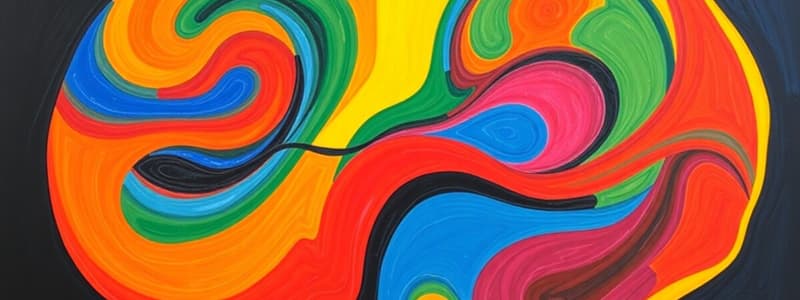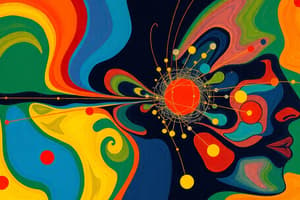Podcast
Questions and Answers
What is the process of converting physical energy into a neural signal called?
What is the process of converting physical energy into a neural signal called?
- Sensation
- Transduction (correct)
- Psychophysics
- Perception
Which of the following is NOT included as a sense organ?
Which of the following is NOT included as a sense organ?
- Skin
- Ears
- Eyes
- Brain (correct)
What does Signal Detection Theory mainly address?
What does Signal Detection Theory mainly address?
- The mechanisms of depth perception.
- How and when a stimulus is detected among background noise. (correct)
- The structures of the vestibular system.
- The absolute thresholds for sensation.
What does Weber's Law state about the Just Noticeable Difference (JND)?
What does Weber's Law state about the Just Noticeable Difference (JND)?
Which of the following best describes the Vestibular Sense?
Which of the following best describes the Vestibular Sense?
What role does perception play in our experience of sensory input?
What role does perception play in our experience of sensory input?
Which factor is NOT mentioned as influencing perception?
Which factor is NOT mentioned as influencing perception?
Which of the following best describes the Absolute Threshold?
Which of the following best describes the Absolute Threshold?
What phenomenon does Inattentional Blindness illustrate?
What phenomenon does Inattentional Blindness illustrate?
What does the term 'Perceptual Constancies' refer to?
What does the term 'Perceptual Constancies' refer to?
Which of the following sensory qualities is NOT part of psychophysics?
Which of the following sensory qualities is NOT part of psychophysics?
What is the difference between sensation and perception?
What is the difference between sensation and perception?
Which of the following depth cues relies on differences in the images between the two eyes?
Which of the following depth cues relies on differences in the images between the two eyes?
Top-Down Processing is primarily influenced by which factor?
Top-Down Processing is primarily influenced by which factor?
What would be an example of the Just Noticeable Difference (JND)?
What would be an example of the Just Noticeable Difference (JND)?
What does the Cocktail Party Effect demonstrate?
What does the Cocktail Party Effect demonstrate?
How do sensory receptors work with physical energy?
How do sensory receptors work with physical energy?
What is the primary focus of psychophysics in the context of sensory perception?
What is the primary focus of psychophysics in the context of sensory perception?
Motion sickness is related to which sensory system?
Motion sickness is related to which sensory system?
What is the primary role of the SEMICIRCULAR CANALS in the vestibular system?
What is the primary role of the SEMICIRCULAR CANALS in the vestibular system?
Flashcards
Sensation
Sensation
The process of detecting, converting, and transmitting raw sensory information from sense receptors to the brain.
Perception
Perception
The process of interpreting and organizing sensory information into meaningful patterns in the brain.
Psychophysics
Psychophysics
The study of the relationship between physical stimuli and the sensations they evoke.
Absolute Threshold
Absolute Threshold
Signup and view all the flashcards
Just Noticeable Difference (JND)
Just Noticeable Difference (JND)
Signup and view all the flashcards
Weber's Law
Weber's Law
Signup and view all the flashcards
Transduction
Transduction
Signup and view all the flashcards
Sensory Receptors
Sensory Receptors
Signup and view all the flashcards
Sense Organs
Sense Organs
Signup and view all the flashcards
Perceptions
Perceptions
Signup and view all the flashcards
Difference Threshold
Difference Threshold
Signup and view all the flashcards
Signal Detection Theory
Signal Detection Theory
Signup and view all the flashcards
Vestibular Sense
Vestibular Sense
Signup and view all the flashcards
Motion Sickness
Motion Sickness
Signup and view all the flashcards
Selective Attention
Selective Attention
Signup and view all the flashcards
Divided Attention
Divided Attention
Signup and view all the flashcards
Perceptual Constancy
Perceptual Constancy
Signup and view all the flashcards
Depth Perception
Depth Perception
Signup and view all the flashcards
Bottom-Up Processing
Bottom-Up Processing
Signup and view all the flashcards
Top-Down Processing
Top-Down Processing
Signup and view all the flashcards
Study Notes
Sensation and Perception
- All knowledge originates from perceptions.
- Sensation involves detecting, converting, and transmitting raw sensory information from sense receptors to the brain.
- Sense organs include eyes, ears, nose, tongue, skin, and internal organs.
- Perception is assembling and combining sensory input into meaningful patterns in the brain.
- Psychophysics studies the relationship between physical stimuli and sensations.
- Examples of physical stimuli include light (brightness, color), sound (volume, pitch), pressure (weight), and taste (sweetness, saltiness).
- Transduction converts physical energy into neural signals.
- Sensory receptors convert physical energy into nerve impulses.
Sensation Thresholds
- Absolute threshold: Minimum stimulation needed to detect a stimulus 50% of the time.
- Just Noticeable Difference (JND): Minimum difference between two stimuli detectable 50% of the time.
- Weber's Law: JND is a constant proportion of the original stimulus intensity; a certain percentage, not an amount, of change.
- Signal Detection Theory: Predicts detection of a stimulus amidst background noise. Detection varies among individuals.
Somesthetic Senses
- Vestibular sense: Balance and body position in space.
- Kinesthetic sense: Body position and movement of body parts.
- Somatosensory touch (pressure, warmth, cold, pain)
Body Position and Movement
- Kinesthesis: Sensation of body part position and movement.
- Vestibular sense: Body position relative to gravity, and sense of balance.
- Semicircular canals (in ears): Filled with fluid that responds to head movements.
- Motion sickness: Vestibular system sensations mismatch with other senses.
Vision and Hearing
- Auditory system transduces rhythmic movement of air molecules into neural impulses.
- Sound waves: Oscillation of pressured transmitted through materials. Frequency and amplitude influence pitch and loudness.
- Sound localization: Sound heard first and loudest in the nearest ear.
Factors influencing Perception
- Selective vs. divided attention: Focusing on one stimulus vs. splitting focus between tasks.
- Cocktail party effect: Ability to attend to one conversation amongst others (figure-ground).
- Inattentional blindness (perceptual blindness): Failure to perceive things while attending to other stimuli.
- Perceptual constancies: Perceiving objects as constant despite changes in retinal images (color, size, shape).
Depth Perception
- Depth perception: Ability to judge distance and see in 3-dimensions.
- Visual Cliff (Gibson): Depth perception study using infants.
Depth Cues
-
Monocular depth cues: Clues to distance using one eye.
-
Accommodation: Lens bending to focus on differing distances.
-
Pictorial depth cues: Cues in the image for space, depth, and distance.
- Linear perspective: Parallel lines converging in the distance.
- Relative size: Larger object appears closer.
- Relative height: Higher object appears farther.
- Light and shadow: Light assumed to come from above.
- Interposition: Nearest object obscuring distant objects.
- Texture gradients: Closer objects have more detail.
-
Binocular depth cues: Clues using two eyes.
-
Convergence: Eyes turning towards objects to see distances under 50 ft.
-
Retinal disparity: Two eyes see two images; disparity difference signals depth.
Perceptual Processing
-
Perceptual expectations (perceptual set): Prior learning guides perception.
-
Top-down processing: Processing influenced by expectations and knowledge. Information starts from high-level processes and moves down.
-
Bottom-up processing: Processing based on stimulus features. Information starts from sensory data and moves up.
-
Parallel processing: Simultaneous processing of several stimuli at once.
-
Perceptual adaptation: Ability to adjust to altered viewing fields.
Studying That Suits You
Use AI to generate personalized quizzes and flashcards to suit your learning preferences.




